Long day’s journey into night
The electoral college math
Unlike most other democracies, the winner of the US presidential election is not determined by the national popular vote. The outcome is determined by whoever wins at least 270 electoral college votes. And so, while Joe Biden leads in most national polls, it is the state-wide races that will matter when predicting the outcome of the election.
The election will likely be determined by how swing states or battleground states vote on 3 November. These states are aptly described as “swing” states because they do not reliably vote red (Republican) or blue (Democrat) in any given election; that is they can swing to either side of the political spectrum.
There are six key battleground states this election. They are Arizona, Florida, Michigan, North Carolina, Pennsylvania and Wisconsin, all of which President Donald Trump won in 2016 with less than 50% of the total votes. Back then, in these states, the share of voters who voted for third party candidates was not insignificant, such that it drew away votes from Hillary Clinton and propelled President Trump to a marginal victory. In particular, Trump’s winning margins in the rust belt states – Wisconsin, Pennsylvania and Michigan – were razor thin, ranging from 0.2% to 0.8%, which altogether amounts up to a difference of about 80,000 votes in all three states.
Assuming Joe Biden maintains Hillary Clinton’s electoral map in 2016, the path of least resistance for him to win the White House in November is to flip Wisconsin, Pennsylvania and Michigan from red to blue, netting him 46 additional electoral votes for a grand total of 279 electoral votes – well above the 270 threshold to secure the White House. Polling data in these three states show that Biden may just be able to pull this off. In addition, Wisconsin, Pennsylvania and Michigan had elected Democratic Governors during the mid-term elections in 2018, potentially signalling a switch in political preferences. Hence, the underlying trends in these states may benefit Joe Biden.
According to the Cook Political Report, President Trump’s path to 270 electoral college votes has narrowed considerably, based on the latest polls. Among the states that President Trump cannot afford to lose are what they term the “toss up states” – states where polls are just too close to call – including Florida, Georgia, Iowa, Maine Second Congressional District, North Carolina, Ohio and Texas. Even then, President Trump will still need to retain some of his wins from 2016, including states like Pennsylvania, Michigan and Wisconsin, which are all leaning Democrat according to recent polls.
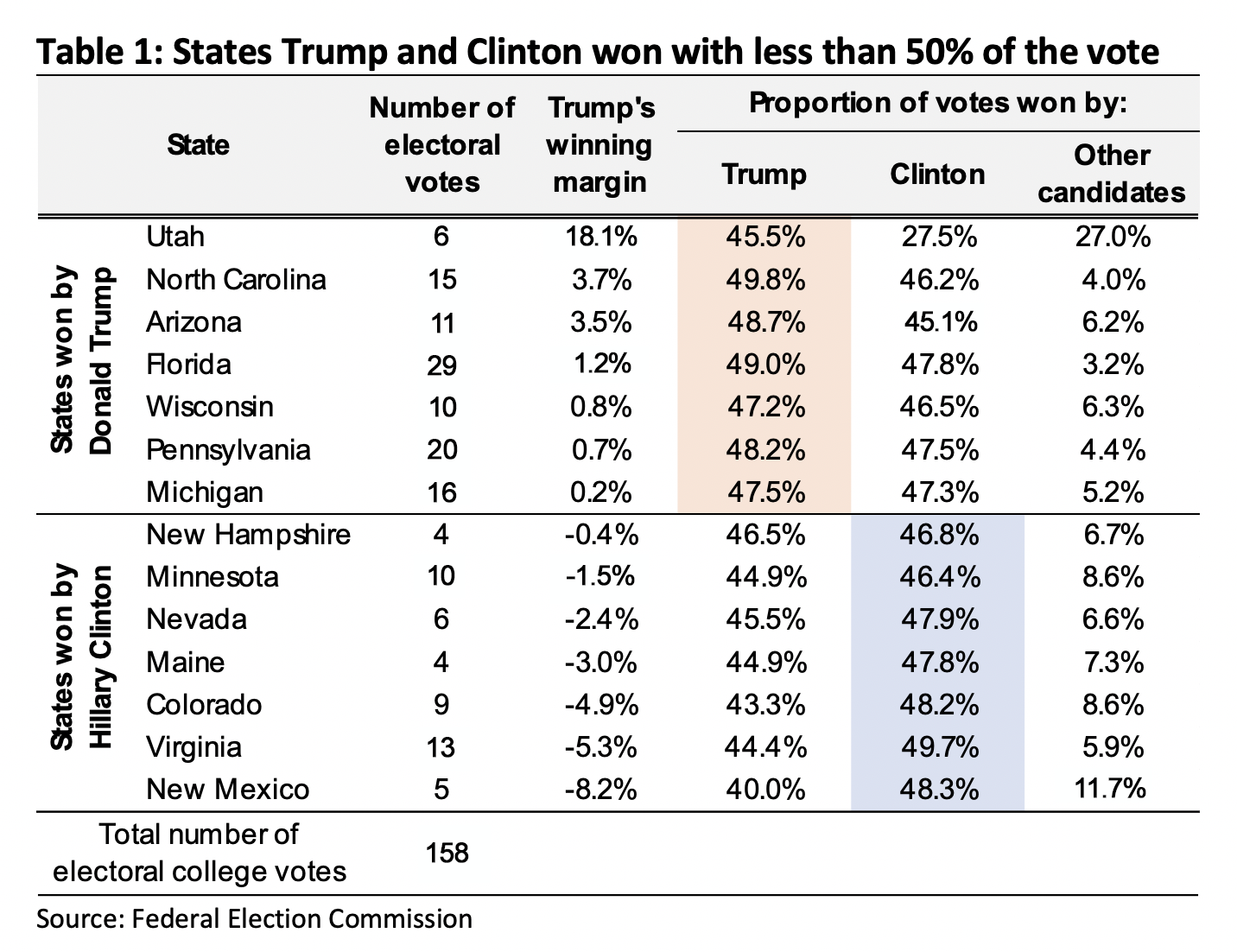
When will we know the results?
Pollsters, political scientists and pundits will continue to speculate the various electoral paths to the White House as polls evolve ahead of the elections, but the more pressing question for the market would be, when will we know the final outcome? Will it be on election night itself (for Singapore that will be Wednesday morning) or are we potentially heading towards an extended period of election uncertainty?
To be fair, there is no existing law that requires an election result to be announced on election night. The fanfare of an election night result is largely the product of political news media, in which they announce the projected winner based on exit polling and results from a representative sample of ballots. Election results are seldom certified on the night of the election and election offices have until 8 December this year to formally certify the vote count and resolve all ballot disputes. With the flood of mail-in ballots and other alternative modes of voting during this pandemic, election offices will need the time to verify and count all the ballots received, which is expected come in at unprecedented volumes.
In addition, different states have different rules governing the election process which means that the time taken to arrive at a final tally would vary across states. Some states might be faster at processing mail-in ballots than others, just because they can do it much earlier. This is true for states like North Carolina, Georgia and Florida, which are expected to provide some results on election night.
The final election results for key battleground states like Michigan, Wisconsin and Pennsylvania are not expected until many days later. All three states are likely sitting on record volumes of early mail-in ballots which cannot be processed until a day before (Michigan) or on the day of the election itself (Pennsylvania and Wisconsin), hence likely delaying the announcement of any result.
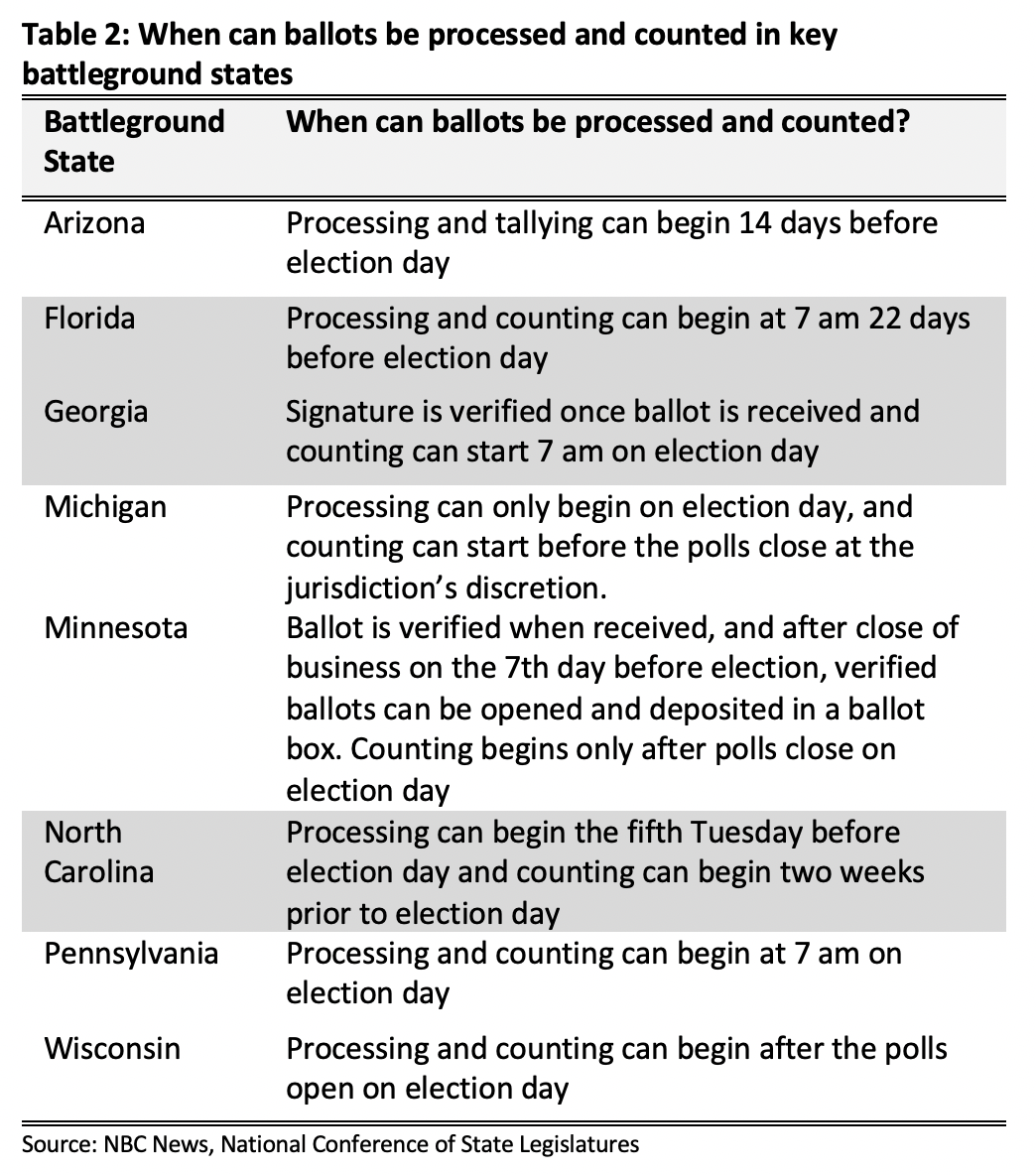
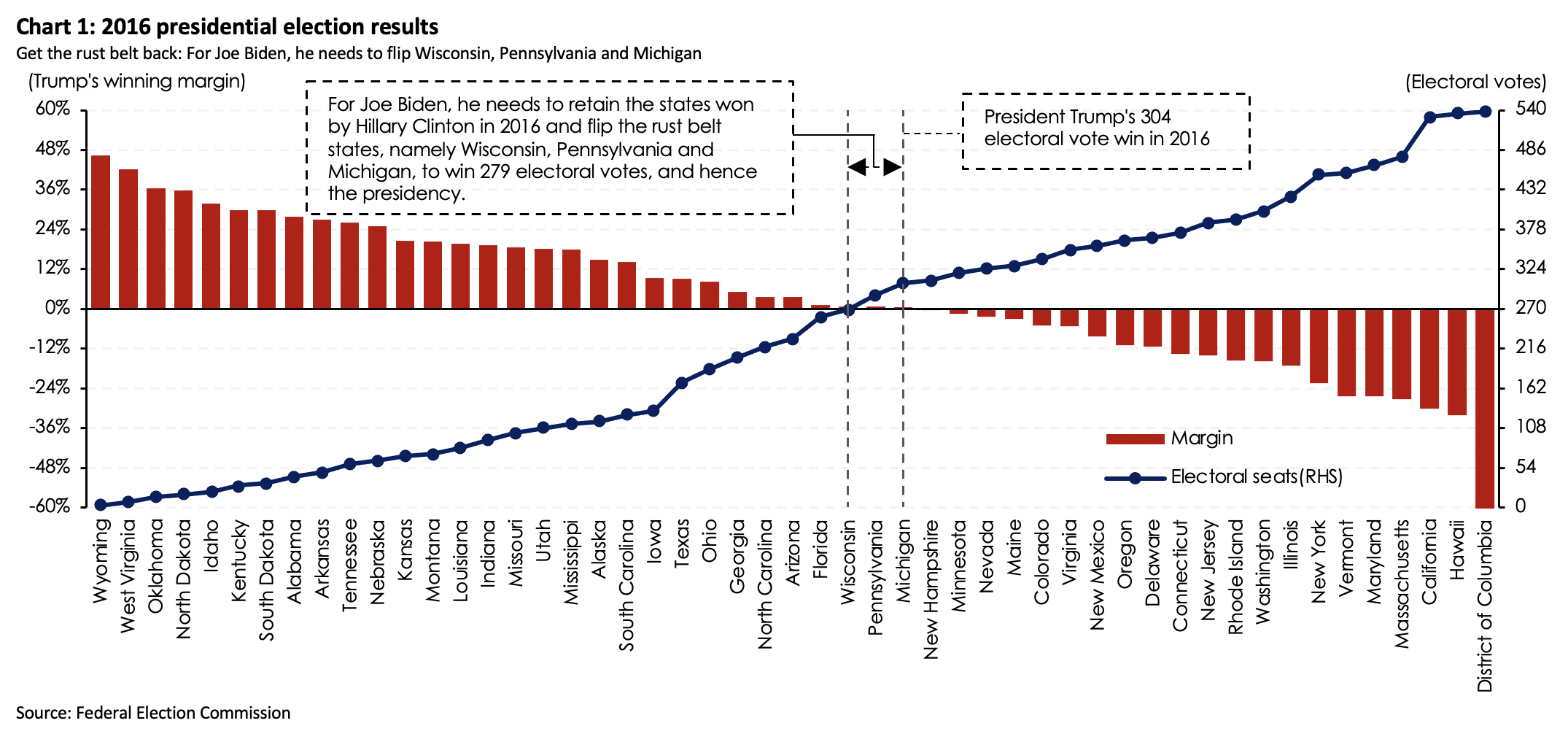
States to watch on election night
Florida, North Carolina and Georgia are among the few states to watch on election night, primarily because these states can process ballots earlier than election day and would be able to announce some preliminary results.
Florida ‒ the Sunshine state
Florida allows ballots to be processed and counted 22 days before election day and the deadline for all ballots to reach election offices is by 7 pm on election day itself, which means its final tally might well be known on the night of the election.
Florida also has important electoral significance. For one, it is the third largest state by population and carries with it a hefty 29 electoral college votes, tying with New York for the third most electoral votes across the 50 states plus the District of Columbia. Only Texas with 38 votes and California with 55 votes exceed Florida. Unlike Texas, California and New York, Florida is a swing state. Texas is reliably a red state, although recent polls suggest it is in play for Democrats this election cycle, while California and New York are reliable blue states. Hence, winning Florida gives the contender a real advantage in terms of electoral votes.
Also, Florida is a key bellwether state for the US presidential election. The swing state has voted for every presidential winner since 1996. Stretching back to 1964, over the span of 14 election cycles, only once has a presidential candidate who succeeded in Florida failed to win the White House, and that was in 1992, when George Bush Snr won Florida but lost the presidential race to Bill Clinton. Coincidentally, eight years later, the state was the centre of partisan drama as George Bush Jr fought hard for state’s 29 electoral votes in a very close fight against Al Gore. With the help of the Supreme Court, the younger Bush won both Florida and the White House. Indeed, the state has quite a strong track record in predicting the ultimate winner of the presidential race. Where Democratic presidential candidates are concerned, only once has a Democratic hopeful won the presidency without winning Florida since 1964, that is Bill Clinton in 1992.
Florida also has a high correlation with other key states when it comes to election results. For instance, Ohio and North Carolina have voted in the same direction as Florida more than 80% of the time over the past 14 election cycles. Pennsylvania, Michigan and Wisconsin have voted the same way as the sunshine state more than 60% of the time since 1964.
Calculations by OCBC Group Treasury Research and Strategy suggests that the correlation between Florida and these rust belt states is particularly strong since 1980, averaging about 0.85.
Its enviable predictive track record is only topped by the state of Ohio. Since 1964, whoever won Ohio has gone on to win the White House. Ohio carries only 18 electoral college votes, but it is still an important bellwether state, especially for Republicans. A popular line often heard in American politics is, “No Republican candidate for the presidency has ever won election without winning Ohio.”
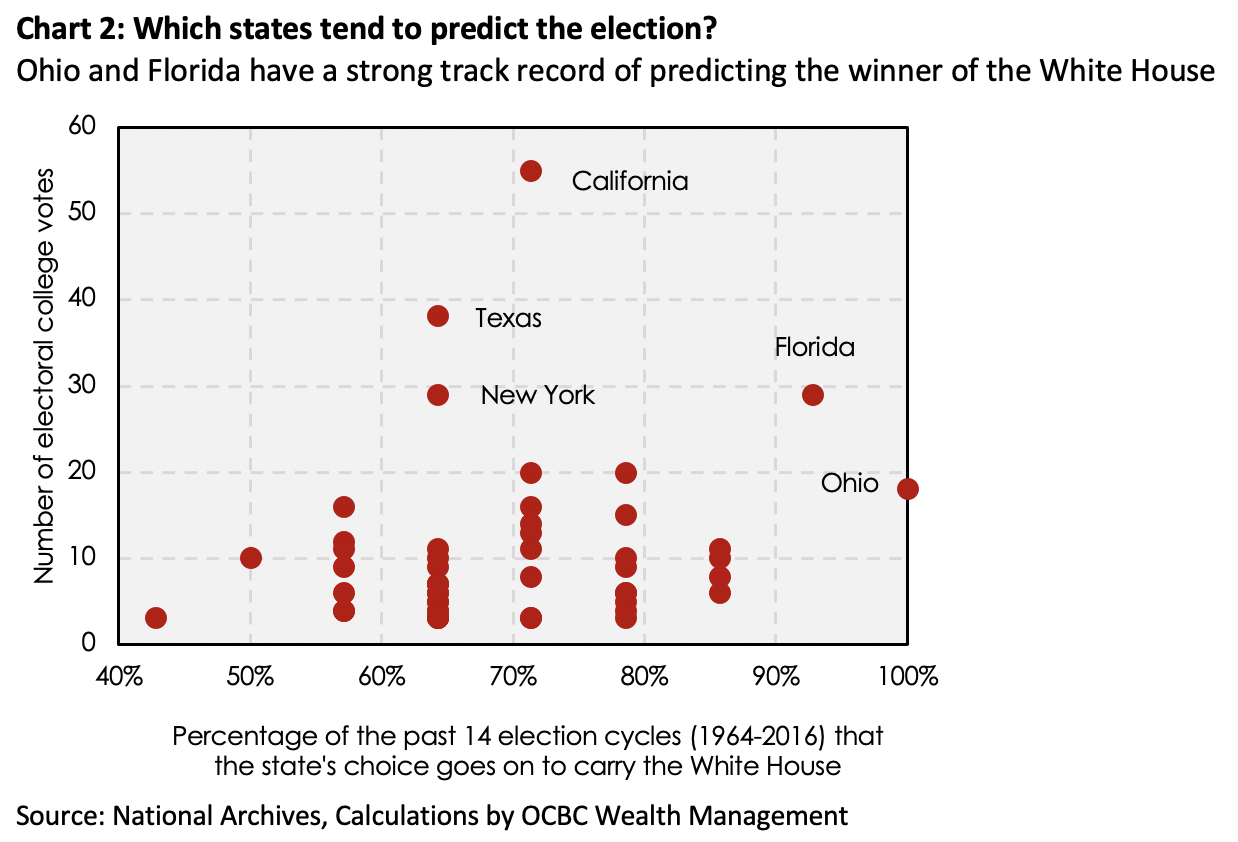
However, because Ohio’s election offices accepts mail-in or absentee ballots received within 10 days following election day if they were postmarked at most one day before the day of the election, the results of Ohio’s race might not be clear until well after election day.
North Carolina ‒ the Tar Heel state
North Carolina is another state to watch on election night (or morning, in Singapore). The term “tar heel” dates back to North Carolina’s early history, when the state was a leading producer of supplies for the naval industry. Workers who distilled turpentine from the sticky sap of pine trees and burned pine boughs to produce tar and pitch often went barefoot during hot summer months and undoubtedly collected tar on their heels. “Tar heels” became an expression of state pride, and North Carolina became widely known as the “Tar Heel State.”
The state has a long history of voters casting their ballots early, and even though they will continue to accept mail-in ballots after polls close as long as they are postmarked by election day, this is unlikely to make up a significant proportion of voters. Voting rules in North Carolina also allows for early processing and tallying of ballots. In fact, the counting of ballots can begin two weeks before election day. As such, most of the absentee ballots, early voting, and election day results will be available on election night.
The results in North Carolina could indicate if a Democratic sweep is happening. For one, the state’s presidential and senatorial contests are among the tightest in the US. A Biden win in North Carolina will drastically limit President Trump's chance of winning the Electoral College.
A key reason for this is that other swing states such as Michigan, Pennsylvania and Wisconsin are more Democratic leaning than North Carolina. If North Carolina goes blue, there's little chance that President Trump will be able to win states where he is already behind in the polls. If the Democrats carry the senate race in the Tar Heel state, that could be a signal that we’re looking at a Democratic sweep.
Follow the snake
FiveThirtyEight’s snake chart makes this clearer. States that candidates are forecasted to win by huge margins are situated at the ends of the path, while states that are potentially caught up in tight races are found in the middle. The size of the segments relates to the allotment of Electoral College votes – the bigger the segment, the larger the number of votes. Georgia, North Carolina and Florida are situated right at the end of Biden’s path to 270 electoral votes, signalling that the races in these swing states are especially tight.
Coincidentally, these three states are expected to announce results on election night. Georgia’s voting rules allow election offices to process mail-in or absentee ballots as they are received before election day which means it shouldn’t take too much time to tally the ballots. Georgia also has two senate races that are being hotly contested. Should these states flip from red to blue in both the presidential and senatorial races, it could be a major signal that we’re observing a Democratic sweep. After all, these are the tightest races for Joe Biden and the Democrats.
However, if Trump retains a lead over these few states – especially Florida, North Carolina and Ohio – we will likely face an extended period of election uncertainty as focus shifts to the three key rust belt states – Wisconsin, Michigan and Pennsylvania – as they will be key to Biden winning the electoral college. As stated earlier, these states are only expected to announce results days or even weeks later.
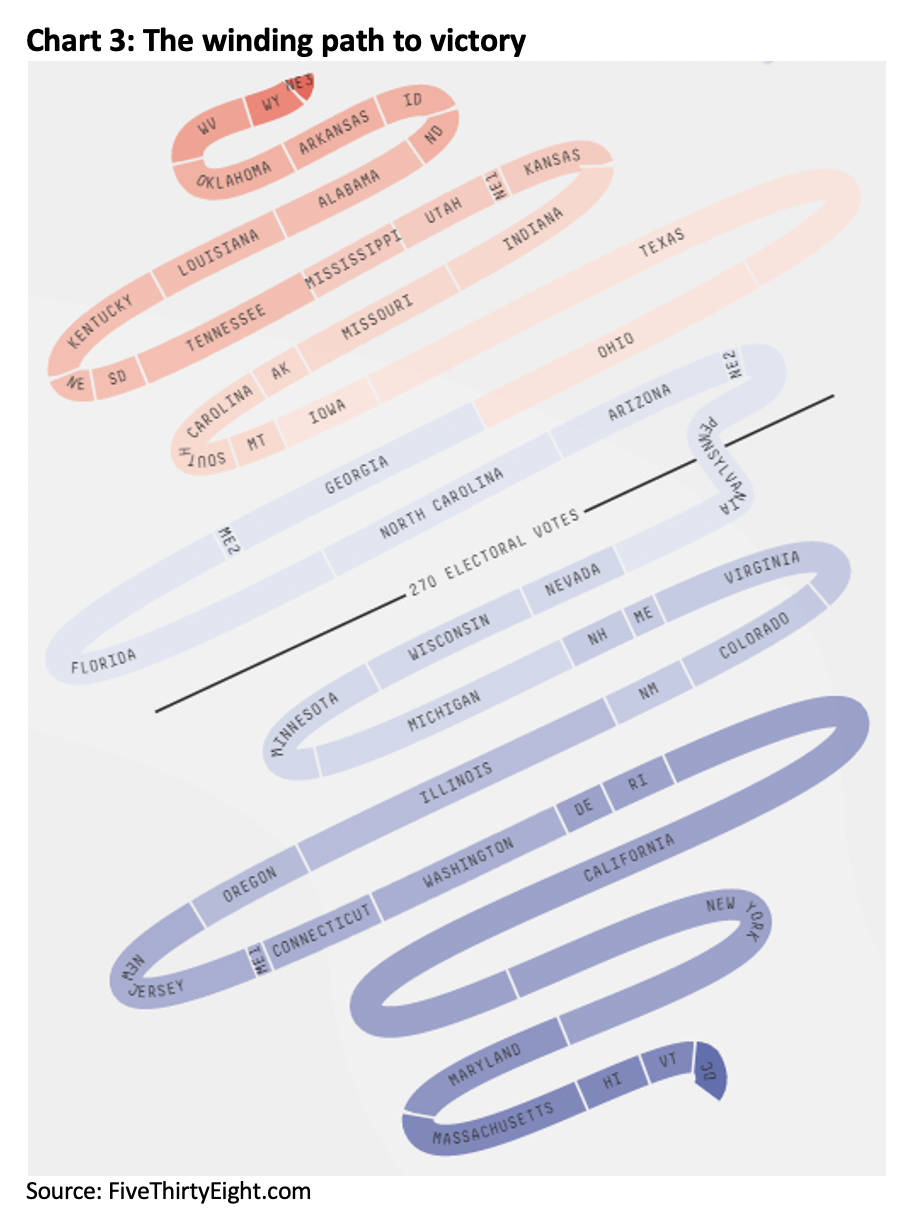
There is always a risk of a contested election
While polls still suggest that Biden could still win key battleground states rather handily, and therefore the election, it does not immediately extinguish the risk of a contested election. A close race could increase the odds of a drawn-out process with President Trump likely to take legal action to challenge the results, extending the period of uncertainty.
The most recent example was the race between Al Gore and George W Bush in 2000, where less than a thousand votes separated the winner from the loser in the state of Florida, the state that would ultimately decide the winner of the election. This triggered many rounds of recounts and led to a wave of lawsuits that worked its way up to the US Supreme Court.
The weeks of uncertainty battered US stock markets and increased flows into safe haven assets such as the greenback and gold. The same could happen again should the race for the White House come down to the wire.
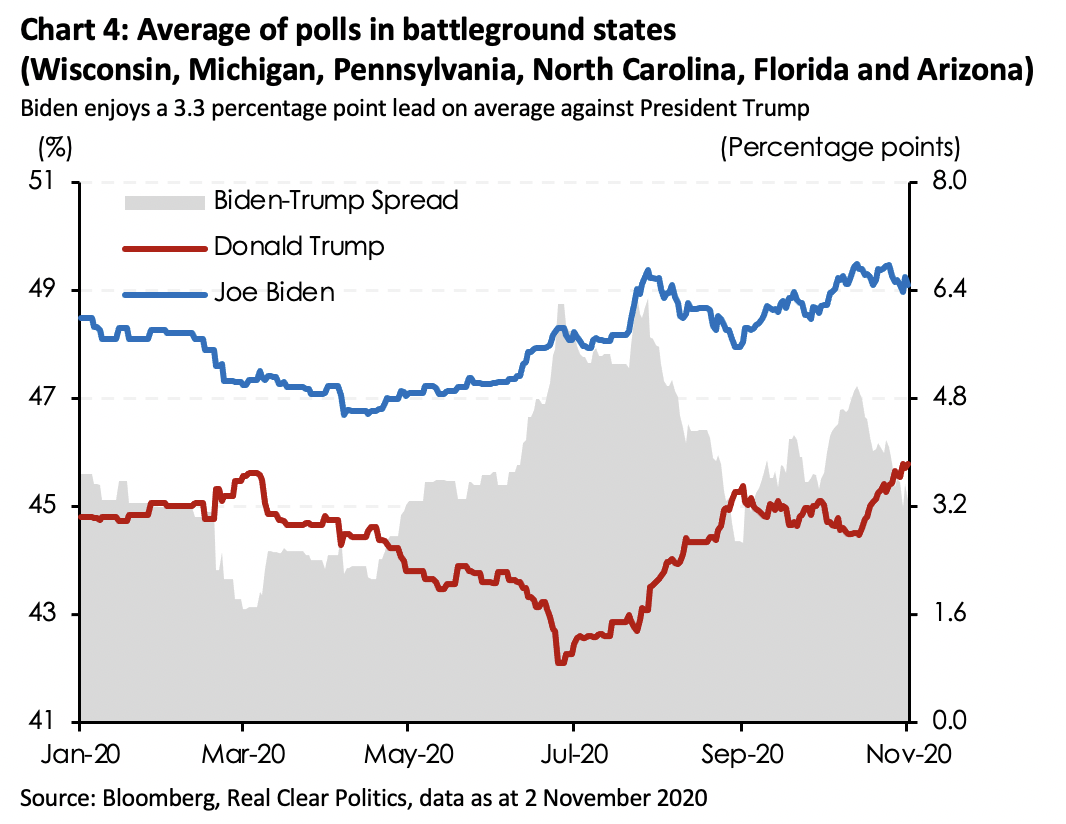
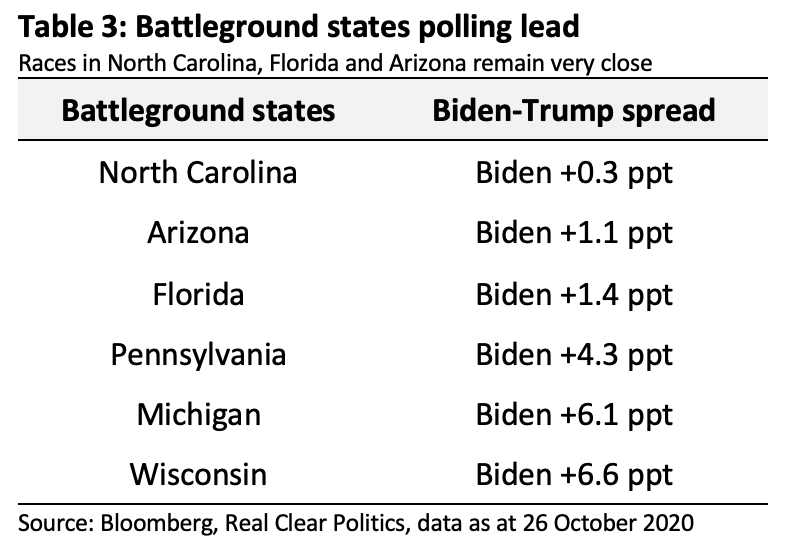
You can also expect confusion emerging in a situation where tallies of in-person votes and mail-in ballots returned before election day show one candidate in the lead, but a tally of uncounted mail-in ballots received late or in subsequent days after the election alters the initial results. Indeed, everything is in play if the election results prove to be too close to call. As it stands, both sides have lawyered up and are waiting for such a time where the courts will decide the fate of the election.
What can investors do
Ahead of a deeply consequential election, investors should heed three points.
- First, stay invested. Politics seldom drive financial markets over the long term and it typically takes time for political outcomes to translate into tangible economic policies that may or may not have far reaching implications for financial markets. Being exposed to the market upside is just as important as managing the downside risks. The key is to construct and maintain an adequately diversified portfolio, spread across various asset classes and regional markets.
- Second, making directional bets on political events is often problematic and investors should avoid doing so. The better strategy is to position for a rise in volatility, which tends to spike going into such uncertain events. This was the case during Brexit and the US elections in 2016. We continue to advocate portfolio diversification to navigate choppy markets. In a year rife with uncertainty, this has never been more important.
Within equities, a sensible strategy to hedge against election-related uncertainty is to tilt portfolios towards high-quality names with growth prospects that are not dependent on any specific political outcomes. Alternatively, investors could focus on broad sectors that may benefit from a bipartisan agenda. Infrastructure spending is a good example. It is a theme that is broadly discussed on both sides of the political aisle and could be a policy focus in most potential outcomes. In this case, cyclical sectors such as industrials stand to benefit.
While maintaining exposure to names that ride on secular growth trends is important for long-term performance, it might be opportune to rebalance portfolio weights in growth and momentum stocks – particularly in the US information technology and healthcare sectors – that have significantly outperformed into cyclical and value names with resilient balance sheets and stable business models that should benefit from the long-term economic recovery. - Lastly, do not panic sell. If you heed points 1 and 2, you probably may not have to face this. Nevertheless, when things shock us, we tend to resort to extremes, often to our detriment. It pays to remember that as with all initial risk-off phases, markets tend to overreact before finding a bottom, at which point valuations and fundamentals become extremely compelling and the market rises. It’s a cycle. The key is to remain calm, assess the risks, be a little patient and execute your next move.
The information provided herein is intended for general circulation and/or discussion purposes only. It does not take into account the specific investment objectives, financial situation or particular needs of any particular person.
Please seek advice from a financial adviser regarding the suitability of any investment product taking into account your specific investment objectives, financial situation or particular needs before you make a commitment to purchase any investment product.
The information in this document is not intended to constitute research analysis or recommendation and should not be treated as such. This does not constitute an offer or solicitation to buy or sell or subscribe for any security or financial instrument or to enter into a transaction or to participate in any particular trading or investment strategy.
Some of the contents in this report are summaries of investment ideas and recommendations set out in research reports disseminated by OCBC Bank and its respective associated and connected corporations (“OCBC Group”). For any interest that OCBC Group might have in the securities and/or issuers of the securities, you may request for a copy of the relevant report from your relationship manager.
Any opinions or views of third parties expressed in this material are those of the third parties identified, and not those of OCBC Group.
No representation or warranty whatsoever (including without limitation any representation or warranty as to accuracy, usefulness, adequacy, timeliness or completeness) in respect of any information (including without limitation any statement, figures, opinion, view or estimate) provided herein is given by OCBC Bank and it should not be relied upon as such. OCBC Bank does not undertake an obligation to update the information or to correct any inaccuracy that may become apparent at a later time. All information presented is subject to change without notice. OCBC Bank shall not be responsible or liable for any loss or damage whatsoever arising directly or indirectly howsoever in connection with or as a result of any person acting on any information provided herein.
OCBC Bank, its related companies, their respective directors and/or employees (collectively “Related Persons”) may or might have in the future interests in the investment products or the issuers mentioned herein. Such interests include effecting transactions in such investment products, and providing broking, investment banking and other financial services to such issuers. OCBC Bank and its Related Persons may also be related to, and receive fees from, providers of such investment products.
The information provided herein may contain projections or other forward-looking statement regarding future events or future performance of countries, assets, markets or companies. Actual events or results may differ materially. Past performance figures are not necessarily indicative of future or likely performance. Any reference to any specific company, financial product or asset class in whatever way is used for illustrative purposes only and does not constitute a recommendation on the same.
Investors should note that there are necessarily limitations and difficulties in using any graph, chart, formula or other device to determine whether or not, or if so, when to, make an investment.
The contents hereof are considered proprietary information and may not be reproduced or disseminated in whole or in part without OCBC Bank’s written consent.
Cross-Border Marketing Disclaimers
Please click here for OCBC Bank's cross border marketing disclaimers relevant for your country of residence.





